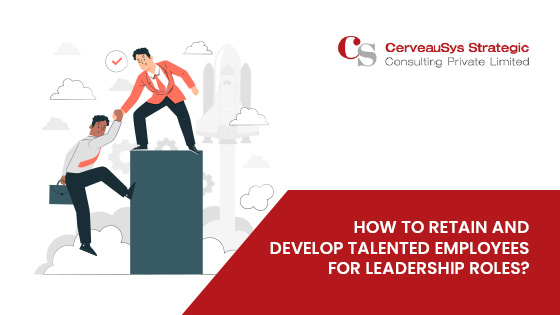HOW TO RETAIN AND DEVELOP TALENTED EMPLOYEES FOR LEADERSHIP ROLES?

Employee turnover is expensive! When talented employees leave an organization, they take with them years or even decades’ worth of institutional knowledge and honed skills that are lost when they depart. Having to find and onboard a replacement burdens teams with weeks of reduced productivity and capacity while the new hire gets up to speed. Plus, vital relationships cultivated with stakeholders and partners can be damaged without continuity.
Overall, experts estimate that losing an employee costs a staggering one to two times that person’s salary when factoring in lost productivity, hiring costs, training investments, and ramp-up time. For these reasons, retaining top talent must be mission-critical, rather than an afterthought, for organizations wanting to protect their bottom line and competitive advantage.
Why Do Talented Employees Leave?
There are many reasons why star employees quit, including:
- Lack of Growth Opportunities: Talented employees are ambitious and want career progression. Without clear paths for advancement, they will look elsewhere.
- Poor Management: Employees don’t leave companies, they leave managers. Poor leadership, lack of support, and weak feedback cause attrition.
- Workplace Dissatisfaction: Factors like low compensation, excessive workload, lack of work-life balance, and an unpleasant work environment lead to turnover.
- Lack of Development: Employees want opportunities to build new skills. Without investment in their growth, they find their potential stifled.
Retention Strategies: Keeping Your Top Talent
Here are effective strategies to retain your best employees:
- Offer Competitive Compensation Packages: Benchmark pay and benefits to attract and retain top performers. Bonus and incentive structures also help.
- Promote Work-Life Balance: Offer flexible schedules, remote work options, generous time-off policies, onsite amenities, and wellness initiatives.
- Provide Development Opportunities: Invest in continual skills training, seminars, certificates, and tuition reimbursement. Fund conferences and workshops.
- Give Visibility to Leadership: Allow employees to present ideas directly to executives through mentorship initiatives, open office hours, and annual strategy meetings.
- Offer Clear Advancement Opportunities: Develop succession plans detailing possible career trajectories. Outline skills needed for promotions.
- Recognition and Rewards: Celebrate talent consistently. Use rewards like gift cards, events, shout-outs, and wall features highlighting accomplishments.
- Listen and Gather Feedback: Conduct stay interviews exploring why employees remain. Seek input through surveys, town halls, and open communication channels. Act on suggestions.
Development Strategies: Cultivating Future Leaders
To fill your leadership pipeline, you need to actively develop talent. Key strategies include:
- Identify High-Potentials: Assess performance metrics and capabilities to create a pool of possibilities for advancement.
- Create Individual Development Plans: Outline strengths, development areas, short and long-term career goals, and track measurable progress through regular check-ins.
- Offer Stretch Opportunities: High-potential employees thrive on challenge. Provide project leadership roles, committees, task forces, and special assignments with executive exposure.
- Formal Mentorship and Training: Pair emerging leaders with executive and workplace mentors offering guidance. Offer formal leadership development training like executive coaching and 360 reviews.
- Sponsor Rising Talent: Influential executives nominate high-potentials for key assignments, promotions, visibility projects, and opportunities to demonstrate capabilities.
- Continually Evaluate Readiness: Assess leadership benchmarks through assessment centers, skill matrices, and readiness criteria. Identify remaining development needs.
Leadership development must be a priority for organizations seeking to retain and amplify their top talent. This allows companies to fill critical roles smoothly, maintain continuity, leverage institutional knowledge, and boost employee engagement.
Want help creating leadership pipelines tailored to your organizational needs? CerveauSys Strategic offers end-to-end Talent Management solutions factoring in your culture, capabilities benchmarks, and business objectives. Our leadership training programs accelerate readiness timeframes through personalized development blueprints crafted by industry experts.
Discover how our Talent Management consultants can help you retain, develop, and strategically elevate your emerging leaders by visiting https://www.cerveausys.com today!
